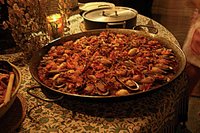It was less than 48 hours before I returned to the Philippines. And my last two days was going to be spent in Kuala Lumpur, the hub of the no-frills airline AirAsia whose revolutionary air ticket rates are changing the airline industry in Malaysia and around Southeast Asia. Our own Cebu Pacific in fact seems to be following suit.
I arrived in the LCC-T of the KLIA at about 6 p.m. Then I took the AirAsia shuttle again from the airport to KL Sentral for RM9. From KL Sentral, I took bus no. 110 to Chinatown, the same bus I rode to the Putrajaya Bus Station. The fare was RM2. I got off at the corner of Jalan Petaling and walked around to look for a guest house. My bags were heavy and since I saw an Indian restaurant first, I decided to have dinner. It was
roti canai and curry dip for me.
Then I continued looking around until finally, I saw a guest house. They didn't have single rooms anymore, but a double was available. The owner offered me a RM5-discount since I was alone so I paid RM30 for a non-aircon double room with a queen-sized bed. Good enough.
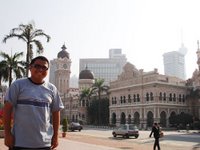
The evening was spent at the guest house resting and re-packing my luggage. A Singapore PY, Siti Mariam, had invited me to meet up since she was studying in Malaysia. I forgot to jot down her number so I went to an internet shop to get it. When I got it, I sent her an SMS and my boring next day suddenly had a long list of things to do.
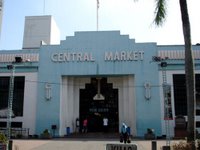
In the morning, I took a walk around the center of Kuala Lumpur and Chinatown. I had breakfast first, again at an Indian restaurant. Then it was off for a walk. Among the sights in the area were Hindu and Chinese temples and old govenment buildings which included the old KL City Hall, the KL Memorial Library, National History Museum and the Sultan Abdul Samad Building (above) all around Merdeka Square, and the art deco Central Market (right).

I would like to make special mention of the adaptive reuse of buildings in KL. Notice the McDonald's store housed in an old colonial building. Why can't McDonald's in the Philippines do the same? They could have done that in Vigan by using reusing the ruins of the old convento. Again, I would like to reiterate that the McDonald's building in Vigan is nothing to be proud of. I hope the City Government of Vigan realizes that since nothing is better than the original. When McDonald's Philippines learns how to respect heritage, indeed that will be the day! Kudos to McDonald's in Malaysia. Notice the signage of the store as well. It does not clash or overpower the architectural details of the building. Bravo!
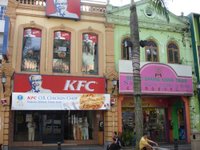
At about 11 a.m., I went back to the guest house to prepare for check out. By 11:30 a.m., I was off to KL Sentral where I would take the KTM Komuter to Serdang. Again, it was bus no. 110 going back to KL Sentral. Serdang was about 30 minutes away from KL and the fare was RM1.70.
Mariam met up with me at the train station and we went to
Universiti Putra Malaysia where she studied, to have lunch. This time, food was Malay. I had a chicken dish with coconut milk, and a beef dish as well. Yummy! Then it started to rain again! Just great!
We were off to
Putrajaya after lunch which was right beside Serdang. Putrajaya is envisioned to be the future capital city of Malaysia and was planned and constructed from scratch. This big investment in city and urban planning is scheduled to be completed in 2012 but the finished structures are already monumental and spectacular!

After asking around at the information office, we were off to the CruiseTasik Putrajaya which is the best way to see this city of the 21st Century. Putrajaya actually reminded me of another capital city in South America which was a result of planning as well. This is the city of Brasilia in Brazil which is in fact a UNESCO World Heritage site. And as the description goes, "Brasilia, a capital created
ex nihilo in the centre of the country in 1956, was a landmark in the history of town planning. Urban planner Lucio Costa and architect Oscar Niemeyer intended that every element – from the layout of the residential and administrative districts (often compared to the shape of a bird in flight) to the symmetry of the buildings themselves – should be in harmony with the city's overall design. The official buildings, in particular, are innovative and imaginative." In just a little over 40 years, the city was inscribed in the UNESCO World Heritage List.
Putrajaya is similar as it was created
ex nihilo (created out of nothing) as well with structures all in harmony with each other. And I wouldn't be surprised if 40 years from now, it is inscribed in the UNESCO list. Other planned capitals include Washington D.C. in the US, Canberra in Australia, and Astana in Kazakhstan. I really hope the government considers doing the same to decongest Manila. In fact, there were proposals to move the capital to Clark. If they do, I hope they plan it as well and as spectacular.
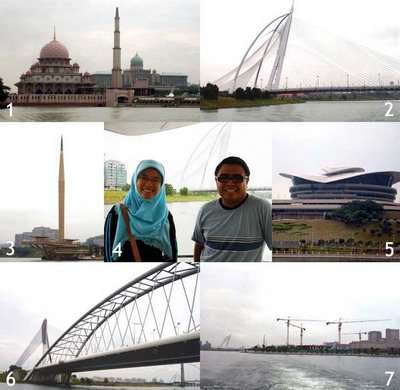
Anyway, we were able to get RM5 discount coupons for the cruise so we paid RM25 for the 45-minute cruise which took us around an island in the center of a man-made lake that offered magnificent views of the city in the making: (1) Putra Mosque and the Prime Minister's Office in the background, (2) Seri Wawasan Bridge, (3) the Millennium Monument, (4) me and Mariam enjoying the cruise, (5) Putrajaya International Convention Center, (6) Seri Saujana Bridge, (7) continuous construction;
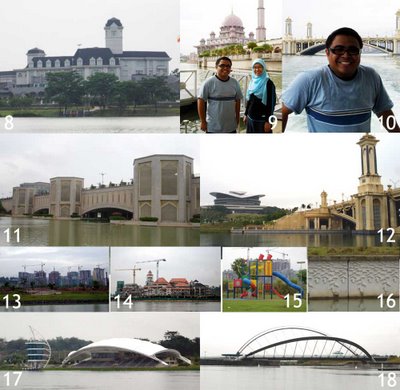
(8) Darul Ehsan Palace, the palace of the sultan of Selangor, (9) me and Mariam in front of the Putra Mosque, (10) me with the Seri Gemilang Bridge at the back, (11) Putra Bridge, (12) the convention center and Seri Gemilang Bridge, (13) and (14) ongoing construction, (15) a playground waiting for children, (16) walls of the lake... even these were artistically done, (17) an amphitheatre and (18) another spectacular bridge.
I think the HULRB needs a revamp! Urban planning in the Philippines is non-existent in the government and it's about time our politicians start creating an urban planning superbody if they still had brain cells left in them after all that squabbling. This body should be manned by nothing less than the best and brightest urban planners and architects who would rework our obsolete land use standards and practices.

After the cruise, we took more photos near the Putra Mosque and the Prime Minister's Office. Then it was back to the train station since I was going to meet up with another SSEAYP batchmate, Jesslyn Wong in Petaling Jaya.
To get to her, I had to take the KTM Komuter back to KL Sentral then transfer to the Putra LRT where I would take a train to Asia Jaya. And I had to do it with all my luggage. Hehe!
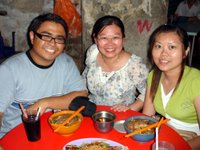
Anyway, Jesslyn passed by for me at the station and we went to Chinatown for dinner. We passed by for her sister who knew the great places to eat at. Today was a great culinary sampling of Malaysia's diversity. In the morning I had Indian, for lunch it was Malay and for dinner, it was Peranakan, a fusion of Chinese and Malay! We had
Asam Laksa, a tamarind-based noodle dish with fish, and Yau Yu, a cuttlefish dish with vegetables and crushed nuts. Yummy!
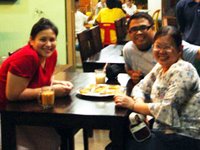
After dinner, we went to meet up with another ex-MaPY, Andrea Chong at a Mamak cafe near her place. This time, I had chicken
murtabak. At 11 p.m., it was off to the airport where I was to spend the night. Since my flight was at 7:15 a.m., that meant a 5:15 a.m. check-in time and I did not want to suffer the hassle of looking for transport at 3:30 a.m. since the airport was an hour and a half away from KL. It turns out, I was not the only one spending the night at the airport since when I got there, all the seats were occupied by sleeping passengers, mostly foreigners. Some had their own sleeping bags with their luggage and other belongings such as surfboards right beside them.
I picked an empty spot and lay down on the cold granite floor to get some sleep. I was up at 5 a.m. maybe since I heard a slight noise when they opened the check-in counters. Sleeping at the airport was indeed a good move. I didn't have to worry about getting there at such an unholy hour and I saved on lodging costs. Hehe! Anyway, after two more hours of waiting at the departure gate, we were off to Clark Field. We arrived in Clark at 11:15 a.m. and that put to a close another great summer backpack trip.
Now that I'm back, it's time to discover more great places around the Philippines. I may have criticized the way our government runs this nation. But we have more things to be proud of as can be seen from the many wonderful places around the country I've been to. Check out my
blog index for backpack ideas around this island paradise called the Philippines.
 The City of San Fernando, Pampanga is host to many festivals, events and traditions. Every Good Friday, people flock to San Pedro Cutud to witness the reenactment of the crucifixion of Jesus Christ by several penitents. Along the route are hundreds of flagellants. In the afternoon, elegant heirloom carrozas and santos are taken out for the largest Good Friday procession in Pampanga which goes around old San Fernando (check out some photos here). In October, there is the Piestang Tugak (Frog Festival) which was first held in 2003 when I was still City Tourism Officer of San Fernando. Throughout the years, it has attracted the crowds and the media with its padwasan (frog-fishing), frog cooking contests and other unique activities. It is now a much-awaited event of San Fernando.
The City of San Fernando, Pampanga is host to many festivals, events and traditions. Every Good Friday, people flock to San Pedro Cutud to witness the reenactment of the crucifixion of Jesus Christ by several penitents. Along the route are hundreds of flagellants. In the afternoon, elegant heirloom carrozas and santos are taken out for the largest Good Friday procession in Pampanga which goes around old San Fernando (check out some photos here). In October, there is the Piestang Tugak (Frog Festival) which was first held in 2003 when I was still City Tourism Officer of San Fernando. Throughout the years, it has attracted the crowds and the media with its padwasan (frog-fishing), frog cooking contests and other unique activities. It is now a much-awaited event of San Fernando. It is indeed the most prestigious social event in Pampanga where, as in the olden days, women would flaunt their best jewelry, gowns and ternos, and men would elegantly dress in their best piña barongs, and dance the night away. El Circulo Fernandino is the oldest surviving social club in Pampanga. Formed sometime in 1920, it was an organization for the social elite of San Fernando. Its precursor was the La Gente Alegre de San Fernando (The Merry Folks).
It is indeed the most prestigious social event in Pampanga where, as in the olden days, women would flaunt their best jewelry, gowns and ternos, and men would elegantly dress in their best piña barongs, and dance the night away. El Circulo Fernandino is the oldest surviving social club in Pampanga. Formed sometime in 1920, it was an organization for the social elite of San Fernando. Its precursor was the La Gente Alegre de San Fernando (The Merry Folks). Larkin later mentions, “the Pampangan elite, a greater number of them emulating late nineteenth century patterns of behavior, turned their attention to peer group organizations, politics, and extra provincial activities. They resolved many if their economic and political problems by banding together into various agricultural organizations and political parties. The trend toward forming upper-class social clubs for amusement also continued. Such groups as the Young Generation in Macabebe, the Kundiman in Angeles, and the Circulo Fernandino in San Fernando were all patterned after organizations formed in the early American years.” Also worth mentioning is the fact that when the town of Santo Tomas was still part of San Fernando, the Thomasian, an organization which organized the annual Sabado de Gloria Ball, was formed. The ball is the oldest uninterrupted social event in Pampanga.
Larkin later mentions, “the Pampangan elite, a greater number of them emulating late nineteenth century patterns of behavior, turned their attention to peer group organizations, politics, and extra provincial activities. They resolved many if their economic and political problems by banding together into various agricultural organizations and political parties. The trend toward forming upper-class social clubs for amusement also continued. Such groups as the Young Generation in Macabebe, the Kundiman in Angeles, and the Circulo Fernandino in San Fernando were all patterned after organizations formed in the early American years.” Also worth mentioning is the fact that when the town of Santo Tomas was still part of San Fernando, the Thomasian, an organization which organized the annual Sabado de Gloria Ball, was formed. The ball is the oldest uninterrupted social event in Pampanga. El Circulo Fernandino organized annuals balls and receptions to achieve this end. All of it however stopped as a result of the hostilities during the Second World War. After the war, the organization again resumed its social activities. But the annual receptions were halted again in 1987.
El Circulo Fernandino organized annuals balls and receptions to achieve this end. All of it however stopped as a result of the hostilities during the Second World War. After the war, the organization again resumed its social activities. But the annual receptions were halted again in 1987.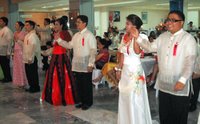 On its 86th year, El Circulo Fernandino is the most-awaited annual social event in the province of Pampanga, where the crème de la crème meet. As part of keeping up with Filipino traditions, the immortal dance classic, the rigodon de honor, is performed by the prominent citizens of the City, men in their best piña barongs and women in dazzling and colorful ternos.
On its 86th year, El Circulo Fernandino is the most-awaited annual social event in the province of Pampanga, where the crème de la crème meet. As part of keeping up with Filipino traditions, the immortal dance classic, the rigodon de honor, is performed by the prominent citizens of the City, men in their best piña barongs and women in dazzling and colorful ternos.


